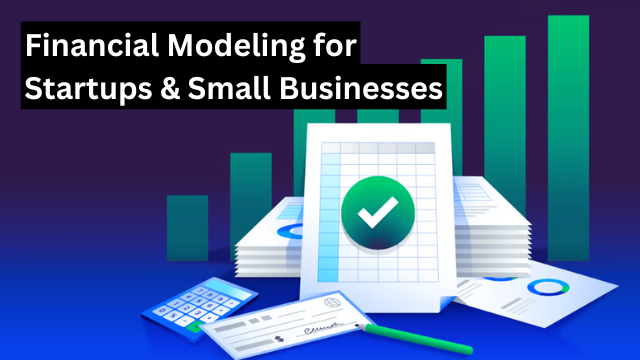In 2025, financial modeling is the backbone of success for startups and small businesses, turning raw ambition into a clear, actionable plan. It’s not just about crunching numbers—it’s about forecasting growth, managing cash, and convincing investors or lenders to back you. This guide walks you through building a practical financial model tailored to the needs of lean startups and agile small businesses. Ready to make your money talk? Let’s get started.
The Power of a Financial Model
A solid model is your business’s GPS. In 2025, it predicts cash flow, tracks profitability, and preps you for funding pitches. Startups use it to show scalability—think “$1M revenue in year three.” Small businesses rely on it to avoid cash crunches—like covering rent during a slow month. It’s your story in numbers, proving you’ve got a grip on the future.
Gather Your Inputs
Start with the basics—data drives accuracy. In 2025, list your revenue sources: a startup might have app subscriptions at $10/month; a small business could tally daily sales, say $300 from a food cart. Next, pin down costs—fixed (e.g., $1,000 rent) and variable (e.g., $2/unit ingredients). Add one-time startup costs—website setup, equipment. Use past receipts or competitor benchmarks (X posts can hint at norms).
Build a Revenue Forecast
Project income with precision. In 2025, break it down—units sold times price. A SaaS startup might assume 100 new users monthly, growing 10%; a retailer could estimate 50 customers daily at $20 each. Factor seasonality—Q4 spikes for holiday sales? Build this in a spreadsheet (Google Sheets is free) with monthly columns for 12–36 months. Conservative estimates win trust over wild guesses.
Detail Your Expenses
Costs shape your runway. In 2025, categorize them—fixed (salaries, utilities) versus variable (ads, shipping). A tech startup might budget $500 for cloud hosting; a boutique could allocate $1,500 for inventory. Include growth costs—hiring at month six? Add it. Use a separate sheet tab to list and sum these, linking totals to your main model. Clarity here prevents surprises.
Cash Flow is Your Lifeline
Track the cash pulse. In 2025, start with your initial balance—$5K from savings? Add monthly revenue, subtract expenses. A startup might burn $2K early, needing a loan; a small business could stay positive at $500/month. Highlight red zones—negative cash triggers action, like cutting costs. A “Cash Flow” tab with running totals keeps you liquid and ready.
Craft a Profit & Loss Statement
Show the bottom line. In 2025, subtract expenses from revenue monthly—profit or loss emerges. A startup might lose $10K year one, banking on scale; a small business targets $2K monthly gains. Summarize annually for trends—investors love this snapshot. Set it up with rows for revenue, costs (COGS, operating), and net income. It’s your profitability proof.
Run Sensitivity Analysis
Plan for the unexpected. In 2025, test scenarios—optimistic (20% sales boost), realistic (base case), pessimistic (10% drop). A startup might tweak user acquisition costs; a small business could adjust supplier prices. Copy your model into new tabs or use Excel’s “What-If Analysis.” This shows resilience—key for funders betting on you.
Model Funding Scenarios
Capital needs pop in your numbers. In 2025, calculate burn rate—monthly loss before profit (e.g., $3K). With $30K cash, you’ve got 10 months—model a $50K investment at month six. Small businesses might add a $10K loan for equipment. Show inflows in cash flow—how long until breakeven? Investors want this math; it’s your ask with evidence.
Keep It User-Friendly
Simplicity scales. In 2025, use one master sheet—revenue at top, expenses below, cash flow and P&L at bottom. Color-code—green for income, red for costs. Add notes (e.g., “assumes 5% churn”) for clarity. Free templates from Bplans or a quick X search can jumpstart you. Make it editable—growth shifts fast.
Validate with Real Data
Numbers lie without reality checks. In 2025, plug in actuals—sales from Stripe, costs from bank statements. A startup might adjust user growth post-launch; a small business could refine after a slow week. Sync weekly via tools like Wave, or manually update. A living model adapts, keeping you on track.
Pitch with Confidence
Your model sells you. In 2025, distill it into a one-page summary—revenue, profit, cash runway—for investors or banks. Pair it with a story: “We’ll hit $100K by year two with this $25K boost.” Practice explaining assumptions—why 5% growth? Data-backed confidence closes deals.
Conclusion
Financial modeling in 2025 is your startup or small business’s secret weapon. Forecast revenue, manage cash, and test the future—all in one tool. Build it lean, keep it real, and use it to steer or pitch. It’s not just accounting—it’s your path to profit. Start modeling now, and take control of your growth.
Frequently Asked Question About Financial Modeling for Startups & Small Businesses
Q1: Why do startups need financial modeling?
Answer: It forecasts cash needs, proves scalability to investors, and guides early decisions with data.
Q2: How can small businesses start modeling with no experience?
Answer: Use a free spreadsheet, list revenue and costs, and follow online templates—keep it basic.
Q3: What’s the most important part of a financial model?
Answer: Cash flow—it shows how long you can operate and when you’ll need funds.
Q4: How often should I update my model in 2025?
Answer: Monthly, or after big changes—real data keeps it accurate and useful.
Q5: What do investors look for in a financial model?
Answer: Realistic revenue growth, clear cost management, and a solid runway—backed by assumptions.A: Monthly, or after big changes—real data keeps it accurate and useful.








